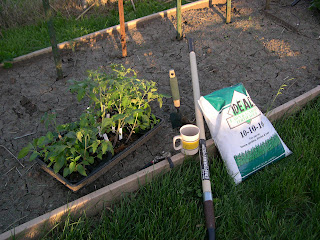
First I lay out the stakes. I use strong fence posts. I feel the plants get loaded with fruit and the cages you see at the store are just too weak to hold them in the wind. I pound them in with a sledge hammer. As the plants grow I tie them with twine. I drive the posts before I plant because I don't want to damage any roots. Here is a picture of the garden bed ready for planting.

Here's everything needed to plant...tomatoes, trowel, fertilizer, and rake.
 Here you can see how the plants did in the fiber grow pots. Overall I would say they did fine. I am planting them with the pots on. I think the roots will grow fine.I'll save my final opinion for when I dig the plants up in the fall. I'll examine the roots then and see if they had good growth and were not restricted by the fiber grow. I've seen that happen with jiffy pellets and peat pots.
Here you can see how the plants did in the fiber grow pots. Overall I would say they did fine. I am planting them with the pots on. I think the roots will grow fine.I'll save my final opinion for when I dig the plants up in the fall. I'll examine the roots then and see if they had good growth and were not restricted by the fiber grow. I've seen that happen with jiffy pellets and peat pots.
Here is the plant ready to go.

First I dig a hole about a foot deep. I use a trowel because I can. My soil isn't too heavy even though there is a lot of clay in it.

I drop about a tablespoon or so of fertilizer in the bottom of the hole. I use standard 10-10-10. If you are an organic gardener you can use organic fertilizer. I wouldn't skip this since tomatoes are heavy feeders.

I then mix the fertilizer with the soil.

Now it's time to prepare the plant. What? You thought we would just drop it in the hole? Silly rabbit! Take a look at all those nice leaves. Now pinch all but the top two or three off.

Here's what it should look like. This wont hurt the plant and actually has some benefit. First, most of those leaves would have been buried anyway. Second, fewer leaves means the plant will need slightly less water when it gets started. Pruning will also force the plant to put it's growing energy into producing new leaves.

Next place the plant in the hole. Nestle it down in the bottom and fill in around the plant. Be gentle. You want to slowly go around from all directions. This keeps the plant upright.

Here you go! All ready for the water! Give it a good drink. Then water it everyday for about 3-4 days depending on the weather. The plants can dry out easily until the roots get growing.

Here are all of them planted.

I also planted my peppers and eggplants. The last thing I did was add a soaker hose. I've been using this for the last couple of years. It allows me to water the roots without getting water on the leaves. Remember, it's the roots that soak up the water and deliver it to the leaves, not the other way around. It's easier to add the hose now than when the plants are larger. You have to be very careful with the small plants cause you could accidentally damage them. Take some time, do it right, and then don't worry about it.

All this took me about 3 hours to do. Now the hard labor of the garden is mostly done. From here on through the summer it's a matter of waiting and watching. Keep an eye out for damage and insects. Make sure the plants get plenty of water, about an inch a week, maybe a little more.

No comments:
Post a Comment